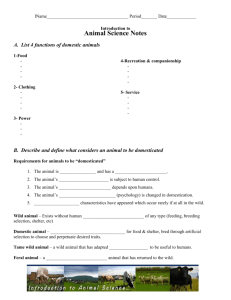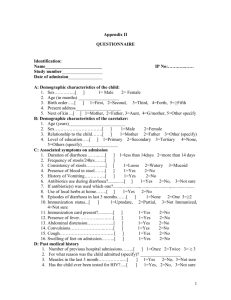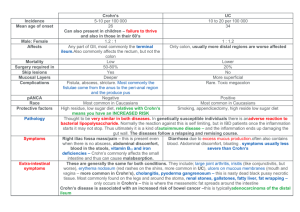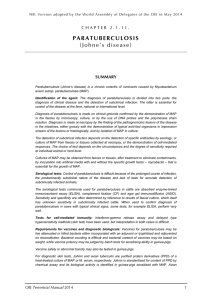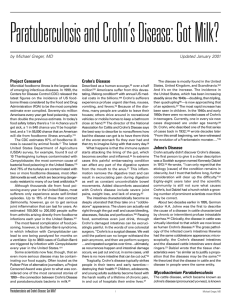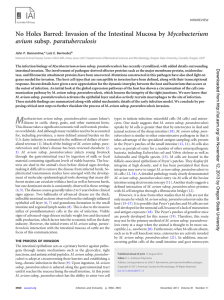Paratuberculosis
advertisement
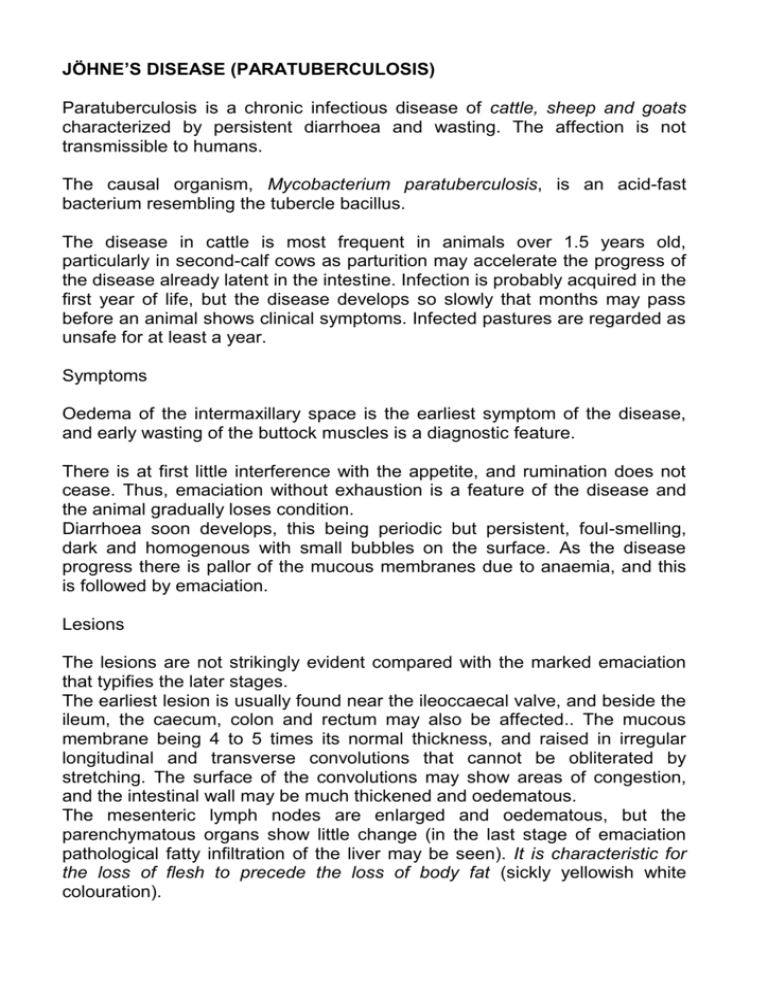
JÖHNE’S DISEASE (PARATUBERCULOSIS) Paratuberculosis is a chronic infectious disease of cattle, sheep and goats characterized by persistent diarrhoea and wasting. The affection is not transmissible to humans. The causal organism, Mycobacterium paratuberculosis, is an acid-fast bacterium resembling the tubercle bacillus. The disease in cattle is most frequent in animals over 1.5 years old, particularly in second-calf cows as parturition may accelerate the progress of the disease already latent in the intestine. Infection is probably acquired in the first year of life, but the disease develops so slowly that months may pass before an animal shows clinical symptoms. Infected pastures are regarded as unsafe for at least a year. Symptoms Oedema of the intermaxillary space is the earliest symptom of the disease, and early wasting of the buttock muscles is a diagnostic feature. There is at first little interference with the appetite, and rumination does not cease. Thus, emaciation without exhaustion is a feature of the disease and the animal gradually loses condition. Diarrhoea soon develops, this being periodic but persistent, foul-smelling, dark and homogenous with small bubbles on the surface. As the disease progress there is pallor of the mucous membranes due to anaemia, and this is followed by emaciation. Lesions The lesions are not strikingly evident compared with the marked emaciation that typifies the later stages. The earliest lesion is usually found near the ileoccaecal valve, and beside the ileum, the caecum, colon and rectum may also be affected.. The mucous membrane being 4 to 5 times its normal thickness, and raised in irregular longitudinal and transverse convolutions that cannot be obliterated by stretching. The surface of the convolutions may show areas of congestion, and the intestinal wall may be much thickened and oedematous. The mesenteric lymph nodes are enlarged and oedematous, but the parenchymatous organs show little change (in the last stage of emaciation pathological fatty infiltration of the liver may be seen). It is characteristic for the loss of flesh to precede the loss of body fat (sickly yellowish white colouration). In sheep the disease frequently coexists with severe intestinal parasitic infection and may be manifested by thickening of the ileum. The intestine may be pigmented an intense yellow. Necrosis, caseation and calcification (never seen in cattle) may be present in the mesenteric lymph nodes and calcified nodules in the intestinal wall. Judgement Many bovine carcases encountered in meat inspection are “borderline” cases between poorness (thin) and emaciation, and present considerable difficulty in judgement. Carcases classified as “poor” may be fit for human consumption food with condemnation of the intestine. Where there is evidence of serous infiltrations with dampness apparent on the serous membranes of the thorax and abdomen, together with lack of setting, it is advisable to detain the carcase overnight in a cool dry athmosphere: a number of carcases will considerably improve in appearance and dryness and, having a value for manufacturing purposes, may safely be passed for food. Definite indications of emaciation or oedema and lack of setting after the detention period warrant total condemnation. CROHN’ DISEASE & MYCOBACTERIUM PARATUBERCULOSIS Crohn’s diseaseof humans is not fatal but causes chronic diarrhoea, persistent abdominal pain, weight loss, tiredness and mental problems. Because it is not notifiable, the number of people affected can only be estimated buti t is thought that up to 80000 suffer from it in Britain, with between 4000 and 8000 new cases every year. The cost to the nation of sufferers’ medical care is estimated to be BPS 240 million per year. Crohn’s disease is almost certainly (in 60-90% of all cases) caused by bacteria found in milk (even if pasteurized) and drinking water supplies. According to research data, up to 55 per cent of dairy herds in western Europe and America are infected with the bacteria, which can survive the pasteurization process. The causative is called Mcobacterium avium subspecies paratuberculosis (MAP) which is difficult to destroy. The normal pasteurization process involves heating milk to 72 °C for 15 seconds but to be sure of killing MAP it would need to be heated to that level for twice as long. MAP can live udetected in cattle for years. Infected cows secrete bacteria into their milk and ont o their pastures. the Tests have proved that MAP causes chronic infection of the intestines of many animals, including 4 types of primates. American studies have isolated MAP from the breast milk of woman with Crohn’s disease but not in woman who do not have the illness. Dairy herds ought to be tested for the infection and the illness ought to be notifiable. The milk should be heated to 80 °C and then allowing itt o cool before drinking it.


